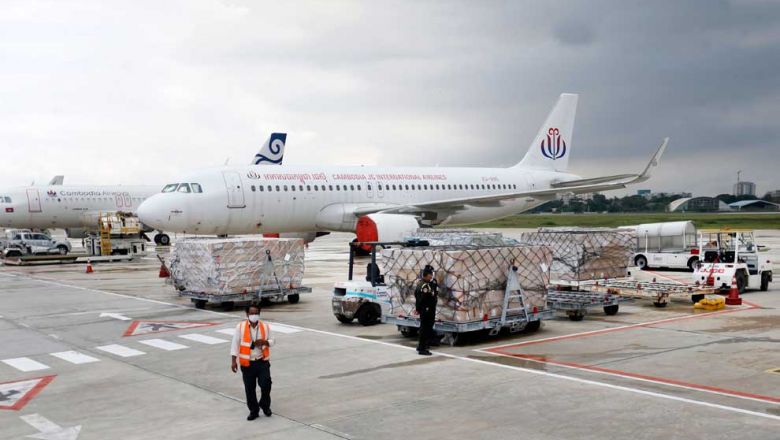Cambodian exports to ASEAN markets rise 13%
Cambodian exports to ASEAN markets rise 13%
The value of Cambodian trade with the nine other ASEAN countries reached $16.053 billion in 2022 – up 1.4 per cent from $15.838 million in 2021 – accounting for a 30.62 per cent share of the Kingdom’s $52.425 billion in total foreign trade for the year, down from a 32.99 per cent share in 2021, according to a Ministry of Commerce report.

The report, issued in conjunction with the ministry’s January 30-31 annual meeting, indicated that Cambodian exports to the nine countries rose by 13 per cent from $2.914 billion in 2021 to $3.297 billion last year, making up 14.7 per cent of the $22.483 billion in total exports.
On the other hand, Cambodian imports from these markets slid by 1.3 per cent from $12.924 billion in 2021 to $12.756 billion last year, comprising 42.60 per cent of the $29.942 billion in total imports.
Vietnam and Thailand alone represented 67.28 per cent of 2022 Cambodian trade with the nine other ASEAN countries, at $6.136 billion and $4.664 billion, respectively, rising by 19.64 per cent and 14.22 per cent on a yearly basis.
Aside from Cambodia, the other nine ASEAN countries are: Brunei, Indonesia, Laos, Malaysia, Myanmar, the Philippines, Singapore, Thailand and Vietnam.
Speaking to The Post on February 5, Cambodia Chamber of Commerce (CCC) vice-president Lim Heng commented that, due to geographical proximity, ASEAN countries are among the top buyers of Cambodian agricultural products, drawing attention to the fact that more than 660 million people live in the region – including the Kingdom’s population.
Of note, Worldometer on February 5 had the ASEAN population at nearly 685 million, a figure it says is based on elaboration of the latest UN data.
Heng claimed that its bilateral free trade agreements (FTA) with China and South Korea have made Cambodia a more powerful magnet for investors in the production of export goods for ASEAN member states.
An FTA is an international treaty between two or more economies designed to reduce or eliminate certain barriers to imports and exports among them, generally while safeguarding safety, security, health and other legitimate regulatory objectives. Such a pact can also serve to facilitate and promote greater economic ties among signatories in areas such as investment and intellectual property protection.
Heng added that the Kingdom is also increasingly acting as a distribution centre for Chinese and South Korean goods destined for the region.
“ASEAN has been an important market for Cambodia, especially since 2015, when member countries began implementing ‘ASEAN economic integration’, despite some setbacks during the Covid-19 pandemic,” he said, predicting that Cambodian trade with regional countries “will be more active” going forward.
Notable Cambodian exports to ASEAN countries encompass agricultural products and raw materials as well as mineral resources to a lesser extent, while major imports include food and beverages, electrical and electronic equipment, construction materials, agricultural machinery and vehicles, according to Heng.
Hong Vanak, director of International Economics at the Royal Academy of Cambodia, described ASEAN as an “indispensable market” for Cambodia, particularly so for the produce traded along the borders with Vietnam, Thailand and Laos – all of which are members of the Southeast Asian bloc.
He noted that shorter transport distances generally translate into cheaper import-export costs and higher profit margins, especially for farmers.
The Kingdom’s collective trade deficit with the other nine ASEAN countries – which according to ministry figures narrowed by 5.5 per cent from $10.01 billion in 2021 to $9.46 billion in 2022 – is “not a big deal”, he argued.
“That’s because Cambodia’s imports are only in part meant to meet domestic demand – they’re also, to a certain extent, raw materials or items used in processing for export elsewhere,” he said.
Vanak believes that agricultural production and exports will remain in positive growth territory for the foreseeable future, supported by the introduction of new government policies that are designed to bolster the sector.
The Ministry of Agriculture, Forestry and Fisheries reported that key agricultural exports to ASEAN countries include milled and paddy rice, cassava, cashew nuts, corn, Faboideae legumes, bananas, mangoes, oil palm (reportedly in fresh-fruit-bunch form), peppercorns, tobacco leaves and rubber latex.
For reference, Faboideae legumes, known in Khmer as “sandek”, comprise most beans, peas, lentils and peanuts, but not tamarinds.













